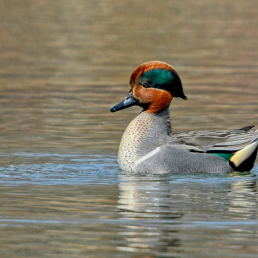

Join BirdNote tomorrow, November 30th!
Illustrator David Sibley and actor H. Jon Benjamin will face off in the bird illustration battle of the century during BirdNote's Year-end Celebration and Auction!
A flock of shorebirds flying wingtip to wingtip seems to act like a single organism, rolling and twisting in exquisite patterns. Flocks like these use a combination of two organizational patterns. One is a “cluster”: lots of birds flying together in a loose, three-dimensional cloud. The second is a basic V-formation, where smaller groups of birds within the flock sync up in V-shapes, like migrating geese. Voilà! Predator avoidance and aerodynamic efficiency.
BirdNote®
Precision Flight in Flocks: How Does It Work?
Written by Bob Sundstrom
This is BirdNote.
[Sound of massed flock of sandpipers: Dunlin ML 59435 recorded by WWH Gunn]
One of nature’s enthralling spectacles is a flock of thousands of shorebirds flying wingtip to wingtip. The huge flock seems to act like a single organism, rolling and twisting in exquisite patterns.
[Sound of massed flock of sandpipers: Dunlin ML 59435 recorded by WWH Gunn]
To better understand how these shorebird flocks operate, scientists analyzed videos of them in flight. Surprisingly, they found that flocks use a combination of two well-known organizational patterns. One is a “cluster”: lots of shorebirds flying together in a loose, three-dimensional cloud. It’s a marvel of precise action that allows the birds to confuse predators and to avoid colliding with one another.
[Short-billed Dowitcher flock calls, https://www.xeno-canto.org/257535, 0.15-.16]
The second kind of pattern is a basic V-formation, where smaller groups of birds within the flock sync up in V-shapes, like migrating geese. The V-formation has a different purpose -- to make flight more efficient, as birds in formation ride off the lift created by birds ahead of them.
The compound pattern combines the advantages of the cluster and the V-formation to improve both predator avoidance and aerodynamic efficiency.
Head to birdnote dot org to see videos of huge shorebird flocks in action.
I’m Mary McCann.
###
Producer: John Kessler
Executive Producer: Sallie Bodie
Editor: Ashley Ahearn
Associate Producer: Ellen Blackstone
Producer: Mark Bramhill
Dunlin ML 59435 recorded by WWH Gunn 0:05 - 0:45, provided by the Macaulay Library at the Cornell Lab of Ornithology. Short-billed Dowitcher XC 257535 provided by Xeno-Canto, recorded by John V. Moore, :45 to end.
BirdNote’s theme was composed and played by Nancy Rumbel and John Kessler.
© 2020 BirdNote June 2020 / 2022 Narrator: Mary McCann
ID# flight-14-2020-06-03 flight-14
New research reference: https://www.sciencedaily.com/releases/2019/06/190604084848.htm




